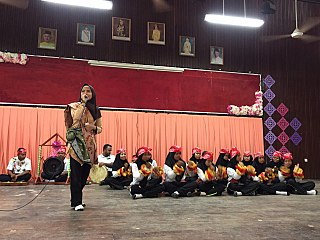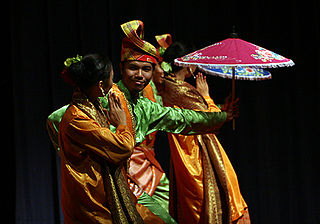 W
WDikir barat is a musical form, native to the Malay Peninsula, that involves singing in groups—often in a competitive setting. Dikir barat may be performed either with a percussion instrumental accompaniment, or with no instruments at all. The dance is partially similar in movement to Endang except that actions of hand clapping are further incorporated to produce rhythm. The origins of dikir barat are unclear; it is found in both Malaysia and Thailand, and today the Malaysia National Department for Culture and Arts actively promotes it as an important part of Malaysian national culture.
 W
WJoget is a traditional Malay dance that originated in Malacca. It was influenced by the Portuguese dance of Branyo which is believed to have been spread to Malacca during the spice trade. In Malacca, it is better known as Chakunchak. The dance is one of the most popular folk dances in Malaysia and normally performed by couples in cultural festivals, weddings and other social functions. Joget also grew in popularity within the Malay community in Singapore after its introduction in 1942.
 W
WMak Yong is a traditional form of dance-drama from northern Malaysia, particularly the state of Kelantan. It was banned by the Pan-Malaysian Islamic Party because of its animist and Hindu-Buddhist roots which pre-date Islam in the Asian region by far. The late Cik Ning was a leading Mak Yong performer in the 1980s. In 2005, UNESCO declared Mak Yong theatre a "Masterpieces of the Oral and Intangible Heritage of Humanity".
 W
WMenora is a type of dance drama originating in Southern Thailand and practised mainly in the northern states of Malaysia and southern provinces of Thailand. Menora also known as Manora Nora (โนรา) in Thai language.
 W
WPayung dance is a folk dance-drama tradition of Minangkabau-Malay ethnic group in Sumatra, Indonesia. This dance is belong to Minangkabau version of Malay dances in Sumatra. Folk theatre such as toneel and sandiwara often performs payung dance as a part of the show. Payung (umbrella) is a main instrument of this dance. Payung dance symbolized affection and relationship of young people that usually performed by three or four dancers in a performance. This dance is originated from West Sumatra, Indonesia.
 W
WRodat is an Indonesian folk dance believed to have originated from the Middle East and was spread to the Indonesian archipelago by the Acehnese traders in the beginning of 19th century. Rodat may have been the combination of two words hadrat Baghdad which means zikir Baghdad.
 W
WRonggeng is a type of Javanese dance in which couples exchange poetic verses as they dance to the music of a rebab or violin and a gong. Ronggeng might have originated from Java in Indonesia.
 W
WUlek Mayang is a classical Malay dance from the state of Terengganu in Malaysia.It is a ritualistic dance performed to appease or invoke the spirits of the sea and is always accompanied by a unique song also called Ulek Mayang. An orchestra comprising drums, gong, violin and accordion accompanies the dance.
 W
WZapin is of the most popular dance and musical forms in traditional Malay performing arts. Elegant dance movements are choreographed to the lively melodies, which are performed using musical instruments such as the gambus, accordion and rebana. It is believed to have been introduced by Persians and Arabs Muslim missionaries from the Middle East to Malay Archipelago around the fourteenth century where back then only males were allowed to perform; nowadays, female dancers are included. It used to be performed exclusively for religious ceremonies but through the years it has become a form of traditional entertainment, hence the participation of female dancers is allowed.
 W
WZapin Api is a firedance technique of the classical Malay Zapin founded in Pulau Rupat Utara, Bengkalis, Riau, Indonesia. The identifying characteristic of Zapin Api is the incorporation of fire and strong focus on the mystical elements. The dance form was historically dormant and extinct for nearly 40 years before its revival in 2013.